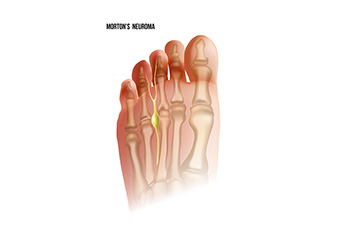Items filtered by date: May 2024
Common Foot Conditions

Our feet, the foundation of our mobility, can often fall victim to various ailments. Achilles tendonitis, inflammation of the Achilles tendon, causes pain and stiffness, often aggravated by overuse or wearing improper footwear. Arthritis, a chronic condition, can affect the joints in the feet, leading to swelling, stiffness, and discomfort. Bunions, bony protrusions at the base of the big toe, result from abnormal foot mechanics or wearing ill-fitting shoes, causing pain and difficulty in walking. Corns, thickened areas of skin caused by friction or pressure, can develop on the toes or soles, causing pain and discomfort. Flat feet, characterized by a lack of arch support, may lead to instability and discomfort during movement. For those with diabetes, foot problems can be particularly concerning due to impaired circulation and nerve damage, increasing the risk of infections and ulcers. If you have any of the above mentioned foot conditions or are experiencing foot pain, it is suggested that you confer with a podiatrist who can accurately diagnose and treat foot ailments.
Foot Pain
Foot pain can be extremely painful and debilitating. If you have a foot pain, consult with Kent Stahl, DPM from Texas. our doctor will assess your condition and provide you with quality foot and ankle treatment.
Causes
Foot pain is a very broad condition that could be caused by one or more ailments. The most common include:
- Bunions
- Hammertoes
- Plantar Fasciitis
- Bone Spurs
- Corns
- Tarsal Tunnel Syndrome
- Ingrown Toenails
- Arthritis (such as Gout, Rheumatoid, and Osteoarthritis)
- Flat Feet
- Injury (from stress fractures, broken toe, foot, ankle, Achilles tendon ruptures, and sprains)
- And more
Diagnosis
To figure out the cause of foot pain, podiatrists utilize several different methods. This can range from simple visual inspections and sensation tests to X-rays and MRI scans. Prior medical history, family medical history, and any recent physical traumatic events will all be taken into consideration for a proper diagnosis.
Treatment
Treatment depends upon the cause of the foot pain. Whether it is resting, staying off the foot, or having surgery; podiatrists have a number of treatment options available for foot pain.
If you have any questions, please feel free to contact our office located in Beaumont, TX . We offer the newest diagnostic and treatment technologies for all your foot care needs.
Facts About Morton's Neuroma

Morton's neuroma, a condition often misunderstood, affects the foot's nerves, particularly between the third and fourth toes. This ailment, named after Thomas George Morton, a 19th-century American surgeon, causes discomfort and pain. The pain is often likened to walking on a pebble or having a fold in the sock. The sensation arises due to the thickening of the tissue surrounding the nerves, leading to irritation and inflammation. Although high-heeled shoes and tight footwear worsen symptoms, anyone can develop Morton's Neuroma. Interestingly, it is not a true neuroma, but rather a perineural fibrosis, which is a thickening of nerve tissue. Diagnosis typically involves clinical evaluation and imaging studies, with treatment options ranging from orthotics and shoe modifications to more invasive procedures like injections or surgery in more severe cases. If you have pain in this part of your foot, it is suggested that you consult a podiatrist who can diagnose and offer correct treatment solutions for Morton’s neuroma.
Morton’s neuroma is a very uncomfortable condition to live with. If you think you have Morton’s neuroma, contact Kent Stahl, DPM of Texas. our doctor will attend to all of your foot care needs and answer any of your related questions.
Morton’s Neuroma
Morton's neuroma is a painful foot condition that commonly affects the areas between the second and third or third and fourth toe, although other areas of the foot are also susceptible. Morton’s neuroma is caused by an inflamed nerve in the foot that is being squeezed and aggravated by surrounding bones.
What Increases the Chances of Having Morton’s Neuroma?
- Ill-fitting high heels or shoes that add pressure to the toe or foot
- Jogging, running or any sport that involves constant impact to the foot
- Flat feet, bunions, and any other foot deformities
Morton’s neuroma is a very treatable condition. Orthotics and shoe inserts can often be used to alleviate the pain on the forefront of the feet. In more severe cases, corticosteroids can also be prescribed. In order to figure out the best treatment for your neuroma, it’s recommended to seek the care of a podiatrist who can diagnose your condition and provide different treatment options.
If you have any questions, please feel free to contact our office located in Beaumont, TX . We offer the newest diagnostic and treatment technologies for all your foot care needs.
Facts About Bunion Surgery

Bunion surgery, known as a bunionectomy, is a common procedure aimed at correcting the misalignment of the big toe joint caused by a bony bump known as a bunion. While bunion surgery can provide relief from pain and improve foot function, it is essential to understand several key facts before undergoing the procedure. Firstly, there are different types of bunion surgeries, ranging from minimally invasive techniques to more extensive procedures depending on the severity of the bunion and individual patient factors. Secondly, recovery from bunion surgery typically involves a period of immobilization followed by exercises to restore strength and flexibility to the foot. Additionally, it is important to have realistic expectations about the outcome of bunion surgery, as full recovery can take several months, and there may still be some residual stiffness or swelling afterward. If you have a bunion and are considering surgery, it is strongly suggested that you seek advice from a podiatrist who can determine if this is a right decision for you.
Foot surgery is sometimes necessary to treat a foot ailment. To learn more, contact Kent Stahl, DPM of Texas. our doctor will assist you with all of your foot and ankle needs.
When Is Surgery Necessary?
Foot and ankle surgery is generally reserved for cases in which less invasive, conservative procedures have failed to alleviate the problem. Some of the cases in which surgery may be necessary include:
- Removing foot deformities like bunions and bone spurs
- Severe arthritis that has caused bone issues
- Cosmetic reconstruction
What Types of Surgery Are There?
The type of surgery you receive will depend on the nature of the problem you have. Some of the possible surgeries include:
- Bunionectomy for painful bunions
- Surgical fusion for realignment of bones
- Neuropathy decompression surgery to treat nerve damage
Benefits of Surgery
Although surgery is usually a last resort, it can provide more complete pain relief compared to non-surgical methods and may allow you to finally resume full activity.
Surgical techniques have also become increasingly sophisticated. Techniques like endoscopic surgery allow for smaller incisions and faster recovery times.
If you have any questions please feel free to contact our office located in Beaumont, TX . We offer the newest diagnostic and treatment technologies for all your foot and ankle needs.
See Your Podiatrist Regularly If You Work On Your Feet
Problematic Flat Feet

Flat feet, or pes planus, is a condition where the arch of the foot collapses, causing the entire sole to touch the ground. There are two types of flat feet. Flexible flat feet is where the arch appears when the foot is off the ground but flattens when bearing weight. Rigid flat feet is where the arch remains flattened regardless of weight-bearing. Symptoms can include pain, swelling, and fatigue in the feet, ankles, or lower legs. Causes range from genetics and aging to injury, obesity, or conditions like arthritis or diabetes. Flat feet can lead to overpronation, increasing the risk of injuries like plantar fasciitis or shin splints. Diagnosis involves physical examination and sometimes imaging tests like X-rays or CT scans. Treatment options include custom orthotic devices, supportive footwear, stretching exercises, and in severe cases, surgery. With proper management, most individuals with flat feet can lead active lives without significant limitations. If you have flat feet that are causing discomfort, it is suggested that you schedule an appointment with a podiatrist for relief options.
Flatfoot is a condition many people suffer from. If you have flat feet, contact Kent Stahl, DPM from Texas. our doctor will treat your foot and ankle needs.
What Are Flat Feet?
Flatfoot is a condition in which the arch of the foot is depressed and the sole of the foot is almost completely in contact with the ground. About 20-30% of the population generally has flat feet because their arches never formed during growth.
Conditions & Problems:
Having flat feet makes it difficult to run or walk because of the stress placed on the ankles.
Alignment – The general alignment of your legs can be disrupted, because the ankles move inward which can cause major discomfort.
Knees – If you have complications with your knees, flat feet can be a contributor to arthritis in that area.
Symptoms
- Pain around the heel or arch area
- Trouble standing on the tip toe
- Swelling around the inside of the ankle
- Flat look to one or both feet
- Having your shoes feel uneven when worn
Treatment
If you are experiencing pain and stress on the foot you may weaken the posterior tibial tendon, which runs around the inside of the ankle.
If you have any questions please feel free to contact our office located in Beaumont, TX . We offer the newest diagnostic and treatment technologies for all your foot and ankle needs.

